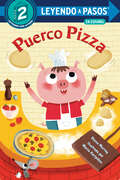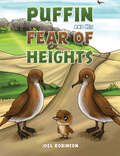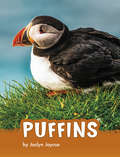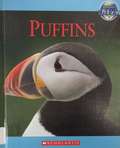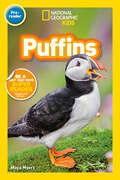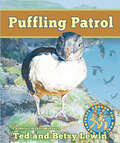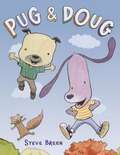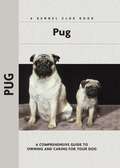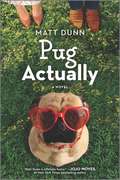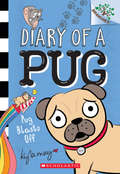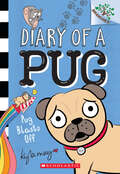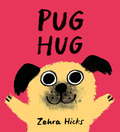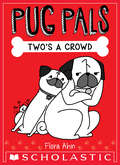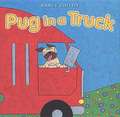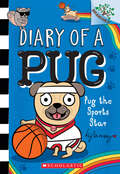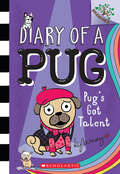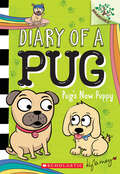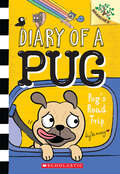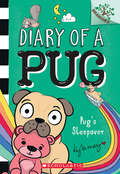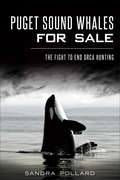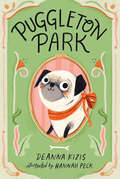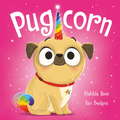- Table View
- List View
Puerco Pizza (LEYENDO A PASOS (Step into Reading))
by Diana MurrayEn esta edición en español del libro nivelado Pizza Pig (Paso 2), los lectores están invitados a la pizzería de Puerco Pizza, ¡donde cada pizza es perfectamente única!Los osos quieren pizza de fresas. Las gaviotas, de almejas. Los clientes de Puerco Pizza pueden pedir lo que quieran en sus pizzas. Entonces, ¿por qué será que Tortuga no come? Resulta que uno es el número más solitario cuando se trata de una pizzería llena de grupos de animales. ¡Lo único que le falta a Tortuga es un amigo con quien compartir! Esta historia rimada sobre la pizza, la compasión y la amistad cautivará a los lectores más jóvenes.LEYENDO A PASOS es una línea de Step into Reading que ofrece ediciones en español de libros nivelados. Los libros Paso 2 usan vocabulario básico y oraciones cortas para contar historias sencillas. Son perfectos para pequeños que identifican algunas palabras visualmente y logran leer palabras nuevas con un poco de ayuda. Kindness is on the menu in this Spanish edition of this Step 2 beginning reader! Pizza Pig's pizza parlor is the place to be, where animals can order whatever their taste buds desire. Bears get pizza topped with jam. Gulls get pizza topped with clams. Customers at Pizza Pig's get whatever they want on their pizzas! But why isn't Turtle eating? It turns out that one is the loneliest number when it comes to a bustling pizza joint filled with groups of animals. All Turtle needs is a friend to whet her appetite! This rhyming story in Spanish about pizza, compassion, and friendship is sure to tickle young readers. LEYENDO A PASOS is a line from Step into Reading offering leveled readers in Spanish. Step 2 readers use basic vocabulary and short sentences to tell simple stories. They are perfect for children who recognize familiar words and can sound out new words with help. Rhyme and rhythmic text paired with picture clues help children decode the story.
Puffin and His Fear of Heights
by Joel RobinsonJoin Puffin, a brave Shearwater chick, on a heartwarming journey to conquer his fear of heights. Born in a burrow on Heron Island, Puffin longs to fly and play with his schoolmates, but his fear holds him back. With the love and support of his family, Puffin faces his fear head-on, taking small steps toward overcoming it. As Puffin gains his wings and soars high in the sky, he inspires birds near and far to be brave and reach for the stars. This uplifting tale teaches children the importance of love, courage, and determination in overcoming their fears.
Puffins (Animals)
by Jaclyn JaycoxPuffins are seabirds with large beaks. They look like a cross between penguins and parrots. Their teeth point backward to help them catch fish. Find out more details about these unique birds.
Puffins (Nature's Children)
by Amy-Jane BeerDescribes physical features, habits and habitat of puffins, the clowns of the sea.
Puffins (Readers)
by Maya MyersFollow Atlantic puffins as they build their nests, fish for yummy snacks, and go about their day. Get to know these quirky birds in this new pre-reader from National Geographic.Perfect for beginning and young readers, National Geographic Pre-readers include simple, expert-vetted text and large, engaging photos on every page. A vocabulary tree at the beginning of the book introduces kids to key words in concept groups, helping kids make connections between words. Plus, a wrap-up activity gives kids a chance to use what they've learned, while expanding their understanding of the world.
Puffins Climb, Penguins Rhyme
by Bruce McmillanJoin in a playful exploration of language while voyaging to opposite ends of the world to observe the natural habitats of Icelandic puffins and Antarctic penguins. Rhyming text and striking photographs illuminate the graceful daily rituals of these two exotic birds.
Puffling Patrol (Adventures Around the World)
by Ted Lewin Betsy LewinTed and Betsy Lewin travel to Iceland to learn about the "Puffling Patrol," a group of children who rescue lost puffins and return them to sea.Every April, the Westman Islands off the coast of Iceland become home to hundreds of thousands of puffins, small black-and-white seabirds with colorful bills. They spend the summer on the rocky cliffs of the islands, caring for their newly hatched chicks. By the middle of August, it is time for the young puffins, called pufflings, to make their way to the sea. And that is when the children of The Puffling Patrol are called to action. Ted and Betsy Lewin have journeyed to the Westman Islands to experience The Puffling Patrol's endeavors firsthand. In the company of Erna, Dáni, and their father, they drive through town at night, carefully searching for confused little birds that have glided down onto the streets instead of out to sea. Will the children find the pufflings before the birds encounter danger? Will the pufflings ever make it to the sea to spend their lives with other puffins in the North Atlantic Ocean? The fascinating story of this unique annual rescue, combined with Ted Lewin's dramatic paintings and Betsy Lewin's lively field sketches, is sure to make Puffling Patrol a hit with animal lovers of all ages.
Pug
by Dog Fancy MagazineDedicated to the Pug, the biggest dog in a toy-dog package, this Smart Owner's Guide, created by the editors at Dog Fancy magazine, offers the most up-to-date and accurate information every dog owner needs to become a well-informed caregiver for his dog. Illustrated with color photographs of adorable puppies and handsome adults, this easy-to-read primer is designed in a modern, lively manner that readers will find user-friendly and entertaining.Each Smart Owner's Guide offers a description of the breed's character and physical conformation, historical overview, and its attributes as a companion dog. The reader will find informative chapters on everything he or she needs to know about acquiring, raising, and training this remarkable purebred dog, including: finding a breeder and selecting a healthy, sound puppy; preparing for the puppy's homecoming, shopping for supplies, and puppy-proofing the home; house-training; veterinary and home health maintenance; feeding and nutrition; and grooming. Obedience training for basic cues (sit, stay, heel, come, etc.) and solving potential problem behaviors (barking, chewing, aggression, jumping up, etc.) are addressed in separate chapters, as are activities to enjoy with the dog, including showing, agility, therapy work, and more.Entertaining tidbits and smart advice fill up colorful sidebars in every chapter, which the editors call "It's a Fact," "Smart Tip," "Notable & Quotable," and "Did You Know?" Real-life heroes and rescue stories are retold in full-page features called "Pop Pups" and "True Tails." Recipes, training, and care tips are highlighted in the "Try This" feature pages.The Smart Owner's Guide series is the only series that offers readers an online component in which dog owners can join a breed-specific online club hosted by dogchannel.com. At Club Pug, owners of the breed can find forums, blogs, and profiles to connect with other breed owners, as well as charts and checklists that can be downloaded. More than just 20,000 pages of solid information, there's a host of fun to be had at the club in the form of downloadable breed-specific e-cards, screensavers, games, and quizzes.The Resources section of the book includes contact information for breed-related organizations and rescues, as well as practical guidance on traveling with dogs, identification, and locating qualified professionals to assist the dog owner, such as pet sitters, trainers, and boarding facilities. This information-packed Smart Owner's Guide is fully indexed.
Pug & Doug
by Steve BreenStep aside, Bert and Ernie, the new odd couple is here! Pug and Doug are best friends. They both love doughnuts, bird watching, and polka music. They are also very different. Doug has a big imagination. Pug…not so much. When a misunderstanding between the friends hurts Doug&’s feelings, Pug must find a way to set things right. This charming and hilarious odd-couple friendship story is perfect for best buddies who usually, but don&’t always, see eye-to-eye.
Pug (Comprehensive Owner's Guide)
by Juliette CunliffeThe experts at Kennel Club Books present the world's largest series of breed-specific canine care books. Each critically acclaimed Comprehensive Owner's Guide covers everything from breed standards to behavior, from training to health and nutrition.
Pug Actually: A Novel
by Matt DunnPOPSUGAR'S BEST BOOKS OF JUNEPARADE'S BEST CANINE BOOKS SUMMER 2021Not all heroes wear capes. Some of them wear collars.A Dog&’s Purpose meets The Happy Ever After Playlist in this charming, pitch-perfect take on relationships as seen through the eyes of a wise pug named Doug, who is determined to play cupid to fix his owner&’s love life with his own four paws.Doug wants his rescuer, Julie, to be happy. He is loyal and loves her unconditionally—two things that can&’t be said about Julie&’s married boss and lover, Luke. Yet Julie is reluctant to break up, afraid to end up like her eccentric cat-owning neighbor. It&’s a prospect that horrifies Doug, too.Newly divorced Tom, on the other hand, is perfect for Julie. Everyone can see it—except for Julie and Tom. Doug is confident that with his help they will get over their initial animosity toward each other.As Doug humorously navigates the quirks of human relationships, he knows he can&’t give up on Julie—after all, being a &“rescue&” works both ways.
Pug Blasts Off (Diary of a Pug #1)
by Kyla MayBaron von Bubbles (Bub) is a pug who wants nothing more than to help his human Bella in her craft projects for school, though he is a little apprehensive about the rocket she is making for the Inventor Challenge—so when he ruins the rocket while trying to get at Nutz the squirrel he needs to find a way to make it up to Bella.
Pug Blasts Off: A Branches Book (Diary of a Pug #1)
by Kyla MayThe first book in a sweet and funny new Branches series about a pug and his human, told from the pug's POV!Pick a book. Grow a Reader!This series is part of Scholastic's early chapter book line, Branches, aimed at newly independent readers. With easy-to-read text, high-interest content, fast-paced plots, and illustrations on every page, these books will boost reading confidence and stamina. Branches books help readers grow!Baron von Bubbles, aka "Bub," is the self-proclaimed cutest pug on the planet! Things he loves: fashion, peanut butter, and his human, Bella. Things he does NOT love: Nutz the squirrel, baths, and the rain. When Bella enters the Spirit of the Inventor Challenge, Bub helps her craft the best project ever. But what happens when Nutz gets on Bub's nerves and makes him ruin Bella's project? If Bub wants to make it up to his girl, he'll have to stand up to Nutz -- and the rain -- once and for all.With four-color artwork throughout, this funny and charming diary-format chapter book is perfect for anyone who believes a furry pal is the best kind of friend.
Pug Hug
by Zehra HicksPug is desperate for a hug. But however hard he tries to hug the other animals, he can't get a hug from anyone! Cat doesn't like hugs, Rabbit is too busy munching carrots and hamster is just too quick! Maybe Croc will give Pug a hug . . . or does he have other ideas?!A sweet and funny tale about finding the perfect hug for Pug!
Pug Pals: Two's a Crowd (Pug Pals Ser. #1)
by Flora AhnA hilarious, highly illustrated chapter book from debut author illustrator, Flora Ahn.Two pugs. One beloved toy bunny. What could go wrong?Sunny's new little sister, Rosy, is getting her paws into everything. When Rosy takes Sunny's favorite toy, Mr. Bunny, and loses him, Sunny is barking mad.But when Rosy sets off on her own to find and rescue Mr. Bunny, Sunny starts to worry. Rosy's never been outside by herself before. Sunny will have to gather all the canine courage she has and go after them -- before Rosy and Mr. Bunny are both lost fur-ever!
Pug in a Truck
by Nancy CoffeltPug and his friend travel far and wide. They deliver goods in their big red truck. Sometimes they see toothpicks, and dragon wagons, even ground clouds . . . So hop in-and make sure to keep the shiny side up and the greasy side down. Because when you’re on the road with Pug, there’s plenty of trucker talk and adventure around every corner!
Pug the Sports Star: A Branches Book (Diary of a Pug)
by Kyla MayThe eleventh Branches early chapter book featuring everyone's favorite pug, Bub, and his human, Bella!Pick a book. Grow a Reader!This series is part of Scholastic's early chapter book line, Branches, aimed at newly independent readers. With easy-to-read text, high-interest content, fast-paced plots, and illustrations on every page, these books will boost reading confidence and stamina. Branches books help readers grow!Bub has a new hobby: BASKETBALL! He's so good, Bella convinces him to become a doggie basketball coach. Bub loves playing, but he isn't sure how he feels about being in the spotlight. Can Bub's friends help him balance being a SPORTS STAR with staying true to himself?With full-color artwork throughout, this funny and charming diary-format early chapter book is perfect for anyone who believes a furry pal is the best kind of friend.
Pug's Got Talent: A Branches Book (Diary of a Pug #4)
by Kyla MayBub, everyone's favorite pug, and his human, Bella, are back in their fourth Branches chapter book!Pick a book. Grow a Reader!This series is part of Scholastic's early chapter book line, Branches, aimed at newly independent readers. With easy-to-read text, high-interest content, fast-paced plots, and illustrations on every page, these books will boost reading confidence and stamina. Branches books help readers grow!Bub's human, Bella, is putting on a pet talent show! Bub can't wait to wow the audience with his skateboarding stunts, not to mention his snazzy costume. But when dress rehearsal doesn't go as planned, Bub finds that it's up to him -- and his archenemy Duchess the cat -- to make things right. Can he and Duchess work together to make sure the show goes on?With full-color artwork throughout, this funny and charming diary-format early chapter book is perfect for anyone who believes a furry pal is the best kind of friend.
Pug's New Puppy: A Branches Book (Diary of a Pug)
by Kyla MayAn eighth Branches early chapter book featuring everyone's favorite pug, Bub, and his human, Bella!Pick a book. Grow a Reader! This series is part of Scholastic's early chapter book line, Branches, aimed at newly independent readers. With easy-to-read text, high-interest content, fast-paced plots, and illustrations on every page, thesebooks will boost reading confidence and stamina. Branches books help readers grow! Bub the pug and his human, Bella, are taking care of Nana's new puppy, Harlow. They can't wait to teach Harlow some new tricks! But training a puppy isn't an easy job. Will they be able to teach Harlow anything before Nana comes home? With full-color artwork throughout, this funny and charming diary-format early chapter book is perfect for anyone who believes a furry pal is the best kind of friend.
Pug's Road Trip: A Branches Book (Diary of a Pug)
by Kyla MayA seventh Branches early chapter book featuring everyone's favorite pug, Bub, and his human, Bella!Pick a book. Grow a Reader! This series is part of Scholastic's early chapter book line, Branches, aimed at newly independent readers. With easy-to-read text, high-interest content, fast-paced plots, and illustrations on every page, these books will boost reading confidence and stamina. Branches books help readers grow! Bub the pug; his human, Bella; and their friend Jack are excited to go on a road trip. There will be so much to see and do! But when Jack can no longer come, Bella and Bub vow to bring him something special from their trip. Can Bub and Bella find the perfect souvenir for Jack? With full-color artwork throughout, this funny and charming diary-format early chapter book is perfect for anyone who believes a furry pal is the best kind of friend.
Pug's Sleepover: A Branches Book (Diary of a Pug)
by Kyla MayA sixth Branches early chapter book featuring everyone's favorite pug, Bub, and his human, Bella!Pick a book. Grow a Reader!This series is part of Scholastic's early chapter book line, Branches, aimed at newly independent readers. With easy-to-read text, high-interest content, fast-paced plots, and illustrations on every page, these books will boost reading confidence and stamina. Branches books help readers grow!Bub the pug and his human, Bella, are planning a pirate-themed sleepover with their friends Jack and Luna. It's going to be epic! But on the night of the party, Jack has a surprise that puts Bella's plans in peril. Can Bub save the sleepover, or will this epic party become an epic fail?With full-color artwork throughout, this funny and charming diary-format early chapter book is perfect for anyone who believes a furry pal is the best kind of friend.
Puget Sound Whales for Sale: The Fight to End Orca Hunting
by Sandra PollardA look at the history of the commercial capturing of orcas in Washington’s Puget Sound, the whales taken, and the efforts to save them. In November, 2005, Washington’s iconic killer whales, known as Southern Resident orcas, were placed on the endangered species list. It was a victory long overdue for a fragile population of fewer than one hundred whales. Author and certified marine naturalist Sandra Pollard traces the story and destinies of the many Southern Resident orcas captured for commercial purposes in or near the Puget Sound between 1964 and 1976. During this time, these highly intelligent members of the dolphin family lost nearly one-third of their population. Drawing on original archive material, this important volume outlines the history of orca captivity while also recounting the harrowing struggle—and ultimate triumph—for the Puget Sound orcas’ freedom.“Making liberal use of interviews, correspondence and newspaper accounts, as well as less intensive use of legislative, governmental, and nonprofit records, Pollard constructs an easily digestible narrative for lay individuals curious about the hunting of Puget Sound’s Northern and Southern Resident killer whale groups between 1965 and 1976. Puget Sound Whales for Sale significantly succeeds the former (Blackfish) in breadth and depth.” —Pacific Northwest Quarterly
Puggle (Designer Dog)
by Miriam Fields-BabineauEach book in the series provides advice about how to locate a healthy, sound puppy from a reputable source and how to properly raise and care for an adorable companion dog.
Puggleton Park #1 (Puggleton Park)
by Deanna KizisMeet Penelope the pug in the first book of this delightful series set in Regency-era London!Penelope is a pleasant little pug who has quite the quandary: All she can remember is that she lost her Lady in the park while chasing the most dreadful squirrel. Now she dreams of one day finding a new Lady and a permanent place to stay. So when she finds herself taken in by the kind Lady Diggleton, she can't believe her luck!But Penelope soon discovers that Lady Diggleton is searching for her previous owner and worries she will have to leave the Lady she's come to love. To make matters worse, that dreadful squirrel keeps poking its nose in wherever Penelope happens to be. However shall she keep herself from chasing it again and ruining all hopes of tea parties, elegant balls, and a forever home? Perfect for readers of the Diary of a Pug series and future fans of Bridgerton and Jane Austen, the adorably illustrated pages of Puggleton Park are sure to charm chapter book readers.
Pugicorn
by Matilda RoseHe's a dog . . . in a unicorns' world!Every year, young princesses and princes arrive at Mrs Paws' Magic Pet shop to pick a perfect unicorn pet. But this year Princess Ava has arrived too late. There are no unicorns left . . . only PUGICORN. He's short and hairy. He can't sit still or gallop gracefully - and he certainly can't leap over rainbows. Can a pugicorn ever be a princess's best friend? The trend for pugicorns is taking off - and you'd be barking mad to miss it!
